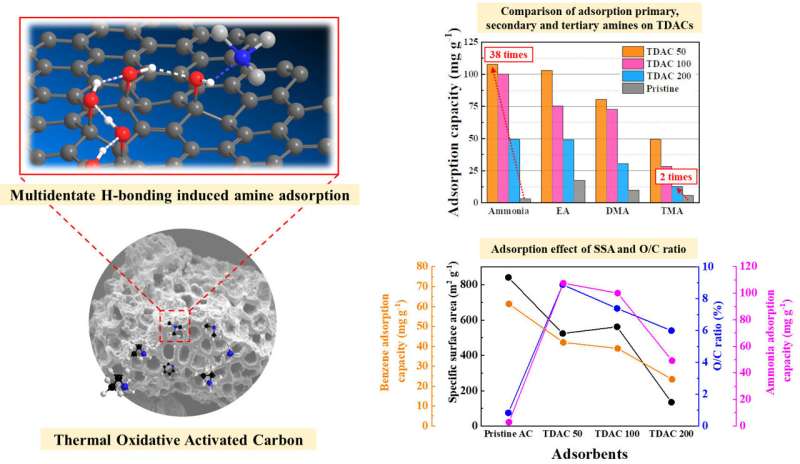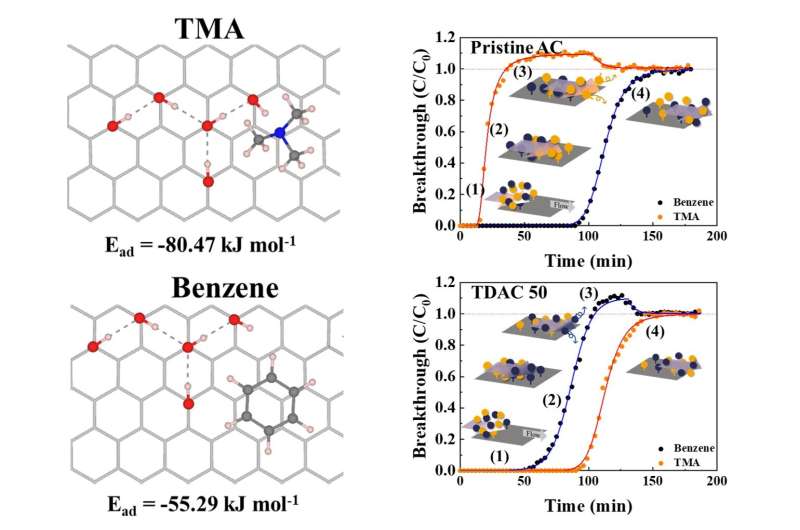This article has been reviewed according to Science X's editorial process and policies. Editors have highlighted the following attributes while ensuring the content's credibility:
fact-checked
peer-reviewed publication
proofread
New technology for dramatic reduction of daily odors

Odorous gases, which are unpleasant and strongly irritating to the eyes, nose, and respiratory tract, are ubiquitous in facilities such as septic tanks, sewage systems, livestock farms, and waste disposal plants. These gases exert a negative impact on the human body as well as the surrounding environment, thus numerous ways have been developed to eliminate them. Typical odor removal methods use activated carbon as an adsorbent.
However, activated carbon has low recyclability, making it difficult to remove the sources of complex odorous gases for reuse.
A research team led by Dr. Jiwon Lee and Youngtak Oh of the Sustainable Environment Research Center at the Korea Institute of Science and Technology (KIST) announced that they developed an activated carbon manufacturing technology that dramatically improves the removal of four representative nitrogen-containing odorous compounds (NOCs) from air: ammonia, ethylamine, dimethylamine, and trimethylamine.
Not only did the research team improve the adsorption efficiency of activated carbon for removing odor substances, but they have also discovered the adsorption mechanism between adsorbents and odorous gases, making it possible to develop a wider variety of adsorbents for complex odor substances.
The research team was able to precisely control the degree of surface oxidation to increase the adsorption efficiency of NOCs through an thermal annealing process after oxidizing the activated carbon with nitric acid. They found that the most oxidized heat-treated activated carbon could increase the removal efficiency of odor substances by up to 38 times compared to conventional activated carbon.
For the first time, the researchers revealed that the oxygen atoms on the surface of oxidized activated carbon form strong hydrogen bonds with the amines in nitrogen-containing odor molecules. This finding reflects the principle of optimizing the adsorption effect of NOCs by increasing the degree of oxidation so that more hydrogen bonds can be formed with amines on the surface of activated carbon.
Furthermore, the research team also demonstrated that unlike typical gas reactions, the interaction between the adsorbent and odor substances was primarily influenced by the number of hydrogen bonds, rather than proton affinity.

Furthermore, thermally dried activated carbon(TDAC) was found to increase selectivity for trimethylamine by more than 13 times. This result represents a substantial improvement, as trimethylamine has the lowest adsorption efficiency among conventional NOCs.
Trimethylamine, a designated odor substance regulated by law in Korea, is a typical source of odors in agriculture, landfills, and sewage and waste water treatment plants. In particular, the heat-dried activated carbon has an average recyclability of 93.8% for trimethylamine, showing high economic efficiency compared to the 63% recyclability of conventional activated carbon.
"By identifying the adsorption mechanism of odorous gases, we can develop materials that are specialized for removing specific gases, and heat-dried activated carbon, which undergoes an oxidation process, is relatively simple to produce and can be reused. Thus, it can be applied as a material for purification devices such as filters and masks," claimed Dr. Jiwon Lee of KIST.
The study is published in the Journal of Cleaner Production.
More information: Sooyeol Phyo et al, Adsorption enhancement of hazardous odor gas using controlled thermal oxidation of activated carbon, Journal of Cleaner Production (2023). DOI: 10.1016/j.jclepro.2023.136261
Journal information: Journal of Cleaner Production
Provided by National Research Council of Science & Technology





















